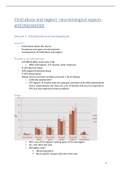Child abuse and neglect: neurobiological aspects
and intervention
Lecture 1: Introduction and consequences
Lecture 1
- Information about this course
- Prevalence and types of maltreatment
- Consequences of child abuse and neglect
Prevalence of maltreatment
- 127.000 children every year in NL
o NPM: self-reports, CPS records, other measures
- 4-16% physical abuse
- 10% neglect/emotional abuse
- 5-10% sexual abuse
- Always hard to estimate numbers precisely = tip of iceberg
o Culturally appropriate?
o CPS reports → records that are used give overview of all child maltreatment
that is substantiated, but there are a lot of families that are not reported to
CPS, but also experience these problems
Types
o EM is one of the highest-ranking types of CA and neglect
o SA = less often the case
o EM higher; why?
▪ Measuring better
▪ More specific reasons why this is the case
1
,Sexual abuse
- Involvement of children in sexual activities that they do not fully understand, are
unable to give informed consent to, for which they are not developmentally
prepared, or that violate the standards of the society in which these children live
(WHO)
Physical abuse
- Any non-accidental injury to a child under the age of 18 by a parent or caretaker.
These injuries may include beatings, shaking, burns, human bites, strangulation, or
immersion in scalding water, with resulting bruises and welts, broken bones, scars,
burns, retinal hemorrhage, or internal injuries
Emotional abuse
- A repeated pattern of caregiver behavior or extreme incident(s) that convey to
children that they are worthless, flawed, unloved, unwanted, endangered, or only of
value in meeting another’s needs
- More active than emotional neglect
Physical neglect
- The chronic failure of a parent or caretaker to provide a child under 18 with basic
needs such as food, clothing, shelter, medical care, educational opportunity,
protection, and supervision
Emotional neglect
- The consistent failure of a parent or caretaker to provide a child with appropriate
support, attention, and affection
Structural neglect
- Institutional rearing characterized by:
o Regimented nature
▪ All very strictly planned
▪ Individual settings do not get space and attention that they need
o High child-to-caregiver ratio
o Multiple shifts
o Frequent change of caregivers
- These factors deprive children of continuous and reciprocal interactions with stable
caregivers, necessary to respond to their developmental needs
2
, → these are the different subjects that will be discussed during the lectures
Consequences of child abuse
- Can child maltreatment make you sick?
- Which illnesses can be the consequence of maltreatment?
- Does it affect your mental health? Examples?
- What are possible methodological limitations that we have to be aware of?
3
, Living standards
- 1958: British birth cohort data (N = 8076)
- Physical neglect (prospective): identified from information collected in childhood
from parental interviews and the child’s teacher by using structured questionnaires
o Asking parents and teachers during childhood
- Emotional neglect and abuse (sexual, physical, psychological, or witnessing): self-
report at age 45
o Physical neglect in childhood and the other types were measured in
adulthood
- Maltreatment related to lower SES → aspects they looked at
o Long-term sickness absence
o Not in employment, education or training
o Fewer assets
o Income-related support
o Lower educational level
o Financial insecurity
o Poor qualifications
o Manual labour
- Adjusted for maternal age, birth weight, birth order, poor childhood health, social
class in 1958, parental education, household amenities, crowding, and tenure
- Results
o Significant association between experiencing child maltreatment at an early
age and your SES at age of 45
o Things that are listed were lower for people that experienced CA and neglect
- Not sure how to explain the relationship
o Not sure what these factors are
4





